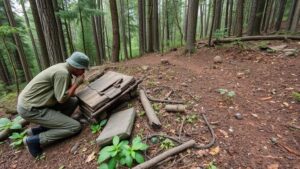Exploring Deep Forests for Evidence of Early Tribal Habitation
Exploring Deep Forests for Evidence of Early Tribal Habitation
The exploration of deep forests for signs of early tribal habitation has become an increasingly important area of study within anthropology, archaeology, and environmental science. These forests, often dense and hard to access, hold valuable clues about human history, including settlement patterns, cultural practices, and interactions with the environment. This article will delve into methodologies, notable discoveries, and the anthropological significance of findings in these verdant landscapes.
The Importance of Forest Ecosystems in Human History
Forests cover approximately 31% of the Earths land area and are home to over 80% of terrestrial biodiversity. This rich environment has not only sustained millions of species but has also provided critical resources for human communities throughout history. Early tribal groups, often mobile and adaptive, utilized forest resources for food, shelter, and materials for tools and crafts.
Research indicates that forests played a significant role in the survival and development of these groups. For example, findings in areas such as the Amazon rainforest demonstrate that indigenous tribes used advanced agricultural techniques and sustainably managed vast stretches of forest to support large communities.
Methodologies for Exploration
- Remote Sensing: Advanced technologies such as satellite imagery and LiDAR (Light Detection and Ranging) are essential tools in exploring dense forests. e methods allow researchers to map terrain and identify potential habitation sites without significant ground disturbance.
- Field Surveys: Archaeologists often conduct systematic surveys in targeted areas identified through remote sensing. These surveys involve walking predetermined paths and examining the ground for artifacts, which provides insight into human activity in the region.
- Excavation: When potential sites are found, excavations are carried out to uncover stratified layers of soil that may contain artifacts, hearths, and other evidence of habitation.
Through these methodologies, researchers can build an understanding of how early tribes lived in the forest and adapted to their environment. A notable example is the exploration of the Pacific Northwest, where submerged archaeological sites have revealed extensive information about the coastal tribes’ reliance on forest resources and marine life.
Significant Findings in Deep Forests
Numerous discoveries have shed light on the lives of early tribal groups. In regions such as Southeast Asia, researchers have found evidence of early agricultural practices interwoven with forest conservation. For example, the discovery of ancient rice paddies within forested areas suggests that tribes practiced a form of agroforestry long before it was formally recognized.
In the Amazon basin, excavations have unearthed earthworks and community structures, indicating sophisticated societal organization. These findings challenge the notion that Amazonian tribes were solely hunter-gatherers and suggest extensive modifications to the landscape through practices such as shifting cultivation.
Another compelling example comes from the forests of North America, where the remnants of ancient villages along rivers reveal how early tribes utilized both terrestrial and aquatic resources. Artifacts such as pottery and tools provide a direct link to the daily lives of these communities, illuminating trade networks and cultural exchanges.
Challenges in Research
Researching deep forests presents numerous challenges, including environmental barriers, funding limitations, and political factors regarding land access. Dense vegetation and difficult terrains often make it hard to conduct thorough investigations, while remote areas may not have the necessary funding for extensive research projects.
Also, the increasing threat of deforestation due to agriculture and urbanization augments the urgency to study these areas rapidly. A study conducted by the World Resources Institute highlights that approximately 18 million hectares of forest are lost each year due to human activity, which directly impacts the archaeological record.
The Anthropological Significance
Understanding early tribal habitation in forests is pivotal not just for reconstructing the past but also for addressing contemporary issues such as biodiversity conservation and indigenous rights. As modern societies grapple with environmental challenges, insights from ancient practices can inform sustainable resource management strategies.
Plus, recognizing the value of traditional ecological knowledge–practices and philosophies developed by indigenous communities–can enhance conservation efforts today. Collaboration with indigenous tribes is paramount in ensuring that exploration is respectful, ethical, and beneficial to both cultural preservation and scientific inquiry.
Conclusion and Actionable Takeaways
The exploration of deep forests for evidence of early tribal habitation is a vital endeavor that enriches our understanding of human history and our relationship with the environment. As researchers employ innovative technologies and methodologies to reveal the complexities of these ancient societies, several actionable takeaways emerge:
- Support interdisciplinary research that combines archaeology, anthropology, and environmental science to ensure a holistic understanding of tribal habitation.
- Advocate for sustainable forest management practices based on insights gained from ancient societies.
- Encourage collaboration with indigenous communities to learn from their invaluable knowledge and experience in managing forest ecosystems.
By further exploring these deep forests, we not only uncover the stories of those who came before us but also strengthen our commitment to preserving their legacies for future generations.

